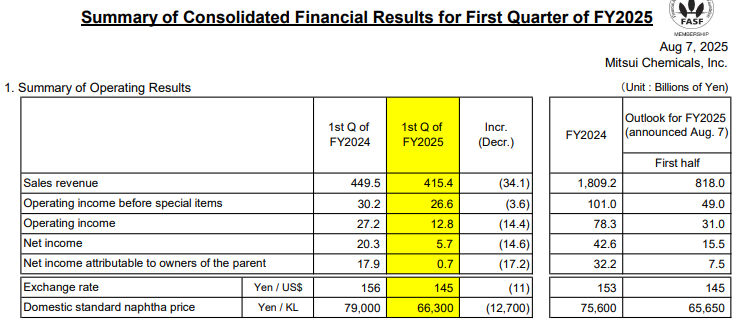Moment of Catastrophe! Mitsui Chemicals Plunges 71.9%
Revenue and profit both declined: In Q1, sales revenue was 415.4 billion yen, a decrease of 34.1 billion yen (down 7.6%) compared to 449.5 billion yen in the same period of fiscal year 2024. Operating profit (before special items) was 26.6 billion yen, down 3.6 billion yen (a decrease of 12.0%) year-on-year. Net profit shrank even more significantly, plunging from 20.3 billion yen to 5.7 billion yen, nearly “halved,” representing a year-on-year drop of approximately 71.92% compared to the first quarter of fiscal year 2024.
External Environmental Impact: The exchange rate of the Japanese yen against the US dollar depreciated from 156 to 145, and the domestic naphtha price decreased from 79,000 yen/KL to 66,300 yen/KL. The dual pressure of raw material costs and exchange rate fluctuations squeezes profit margins.

From a business segment perspective, related sectors such as transportation and automobiles have become "hardest hit areas": sales revenue declined from 140.3 billion yen to 130.2 billion yen, a drop of over 7%, with both volume and price falling (sales volume down 0.7%, price down 10.8%), possibly related to fluctuations in demand within the automotive industry chain and intensified industry competition.
The specialty chemicals domain also faced pressure, with revenue of 255.5 billion yen, a year-on-year decrease of 9.7 billion yen. Prices declined by 14.4%, and although a 4.7% increase in sales volume provided some support, clear signs of a cooling high-end chemicals market were evident.
Only a few sectors, such as Life & Healthcare Solutions, showed slight growth, while the overall business experienced more declines than gains, indicating a serious lack of growth momentum.
Factory Accident Adds Insult to Injury, TDI Supply Pattern Changes
Misfortunes never come singly! On July 27, a sudden chlorine gas leak occurred at Mitsui Chemicals’ Omuta plant, causing the facility to shut down emergency operations. This plant is Mitsui Chemicals’ sole TDI production base. Prior to the accident, it had just completed maintenance, and its capacity had been adjusted from 120,000 tons per year to 50,000 tons per year.
Previously, Japan's TDI capacity had significantly contracted due to the shutdown of TOSOH's facility. After the suspension of Mitsui Chemicals' sole remaining plant, Japan's TDI production has effectively reached "zero capacity," and the country will rely 100% on imports to meet demand in the future. This will not only impact Japan's domestic downstream TDI industries (such as coatings and polyurethane products) but may also trigger a supply-demand rebalance in the Asia-Pacific TDI market—sources from China, South Korea, and others are likely to increase exports to Japan, reshaping global trade flows.
On one hand, there are the "reds and greens" of the performance report, indicating sluggish growth in core business; on the other hand, there is the supply chain disruption caused by a factory accident, leading the TDI business to a standstill. Mitsui Chemicals needs to address in the short term:
Accident Aftermath and Resumption of Production: How to quickly repair the Omuta plant, restore TDI supply, and minimize the impact on downstream customers is key to securing orders and maintaining reputation.
Cost and market competition: To cope with naphtha price fluctuations and exchange rate risks, while regaining growth in specialty chemicals and mobility businesses, it is necessary to recalibrate product strategies and explore emerging markets.
In the long run, the "safety + sustainability" transformation of the chemical industry is imperative. Mitsui Chemicals needs to learn lessons from accidents, strengthen plant safety management, and accelerate the deployment in areas such as green materials and bio-based chemicals in order to find new support points in performance recovery and industrial transformation.
【Copyright and Disclaimer】The above information is collected and organized by PlastMatch. The copyright belongs to the original author. This article is reprinted for the purpose of providing more information, and it does not imply that PlastMatch endorses the views expressed in the article or guarantees its accuracy. If there are any errors in the source attribution or if your legitimate rights have been infringed, please contact us, and we will promptly correct or remove the content. If other media, websites, or individuals use the aforementioned content, they must clearly indicate the original source and origin of the work and assume legal responsibility on their own.
Most Popular
-

List Released! Mexico Announces 50% Tariff On 1,371 China Product Categories
-

EU Changes ELV Regulation Again: Recycled Plastic Content Dispute and Exclusion of Bio-Based Plastics
-

Mexico officially imposes tariffs on 1,400 chinese products, with rates up to 50%
-

Clariant Unveils Cost-Cutting Plan Details, Plans to Shut Down Multiple Plants
-

Nissan Cuts Production of New Leaf EV in Half Due to Battery Shortage






